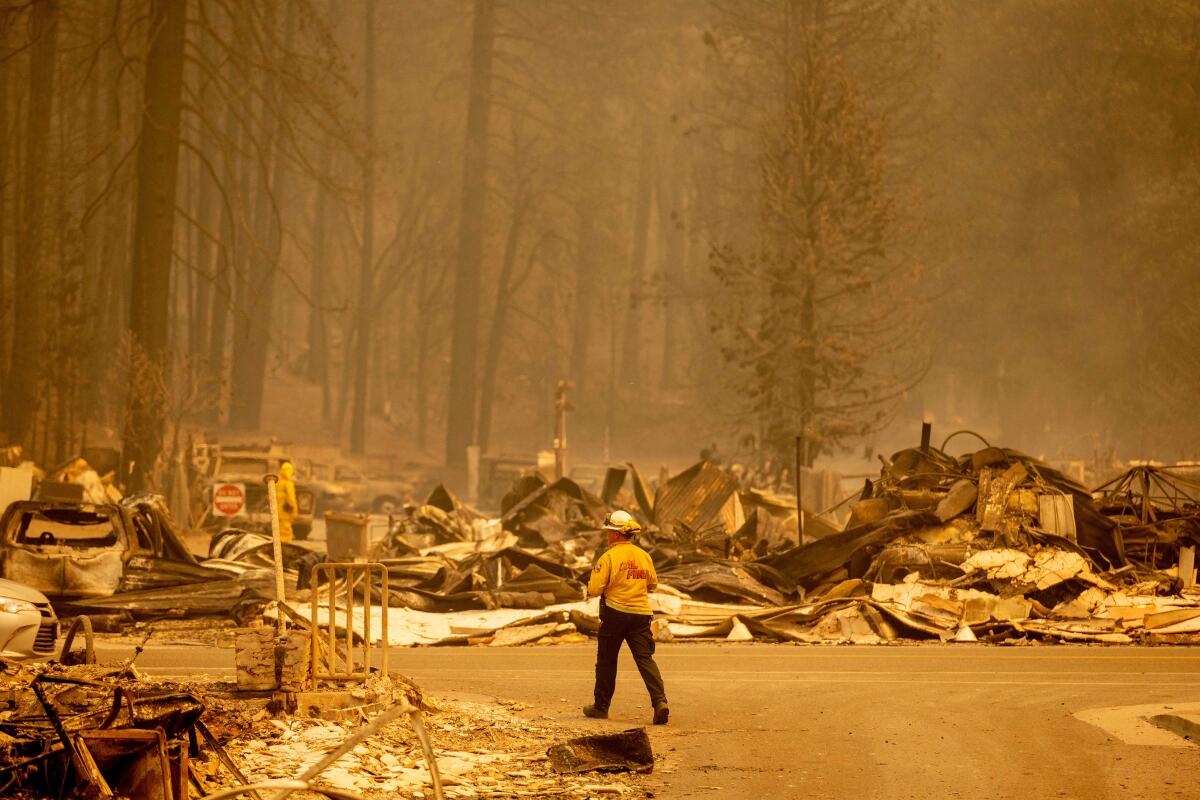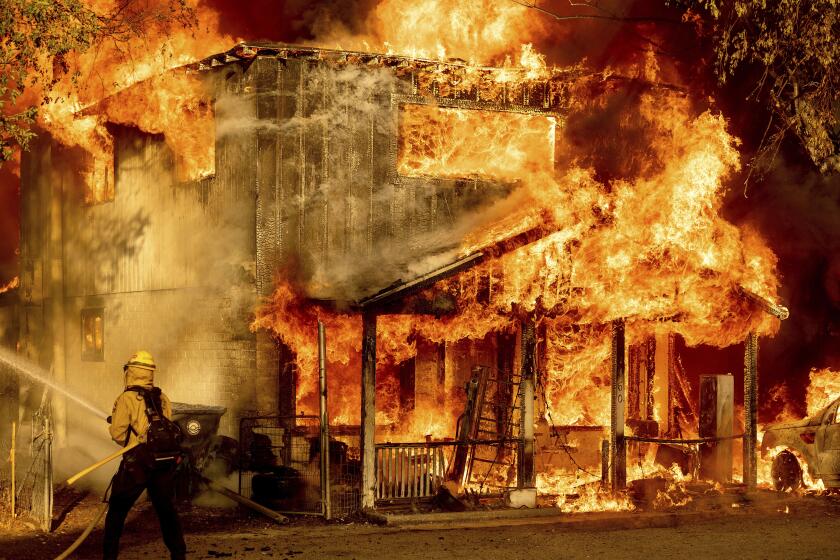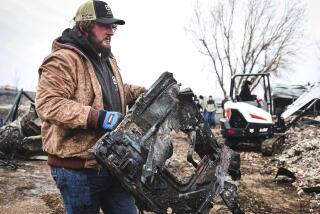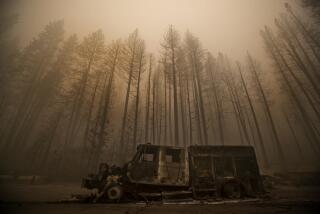Massive fire wipes out much of California town, leaving broken hearts, broken dreams

Curtis Machlan alternated between past and present tense as he spoke about Greenville.
The 58-year-old in 2007 moved to the Gold Rush-era town, where the population sign read more than 2,000 people but where the community numbers just over 1,000.
It’s the town where he met his wife, Kimberly, who had moved to the area in the late 1990s from San Jose.
“We’d go to the local grocery store and sometimes it would take over an hour to get out, just to run in and get a gallon of milk or something, because we knew everybody,” Machlan said.
Greenville, nestled in dense forests southeast of Lake Almanor, was decimated Wednesday when the massive Dixie fire swept through three weeks after it ignited near a Pacific Gas & Electric Co. power station in Feather River Canyon. Authorities said the rapid advance of flames was fed by gusty winds and historically dry conditions, with the National Weather Service issuing a red flag advisory warning of severe fire risk.
“It’s the climate change,” Machlan said. “Everybody who didn’t believe it in Greenville is now a climate refugee.”
Crews were still assessing the damage, but it’s believed that three-quarters of the town’s buildings were consumed, fire spokeswoman Serena Baker said Thursday morning. At least 67 structures were destroyed, with more than 12,000 under threat, according to authorities.
The road to Greenville was still on fire Thursday night.
The town was a smoking ruin, its sign melted so that the lettering crackled like glaze. Entire blocks were razed. Flames still flickered where they could find perches on something left to burn. Hulls of cars lined the street, reduced to charred tanks and melted wheels.
The U.S. Postal Service building was standing, but inside, the banks of P.O. boxes lay collapsed on the ground, their doors burned off. The gas station was smoldering, its metal roof twisted and swollen, its pumps burned-out shells.

At Main and Crescent streets, the historic Bransford & McIntyre Store was reduced to its walls and five steel doors that were meant to protect it from just such a fate. A plaque on the front of the building said the store had been built on this site in the mid-1870s but burned in an 1881 fire. It was immediately replaced with a brick building that, according to a plaque, was “built like a fortress,” complete with “steel shuttered doors and windows.”
None of it was enough to save the store from the Dixie fire.
“The whole historic downtown area is gone,” said Kevin Goss, a Plumas County supervisor who owned a pharmacy that was destroyed. It was the oldest building in town and dated back to 1860, he said.
Goss had gone into town Wednesday and saw the fire jump off the hillside, raining sparks and embers around Greenville.
“That’s when the fire came to town,” he said. “It came through there like a blowtorch.”
Fire officials said they battled the blaze in Greenville for hours, and many people — although not all — fled as the flames approached.
But there was much that could not be saved.
The library where Machlan’s wife once worked burned down. The building that housed the auto parts store where Machlan once worked was gone, too.
On Thursday, he heard from a friend who stayed and tried to fight the fire in a pasture behind the Machlan home. He said the house had been reduced to ash. Neighbors’ homes were also destroyed.
The friend described the scene as a “moonscape.”
“It’s tragic for so many people,” Machlan said, adding that the catastrophe came as no surprise because conditions in the Sierra Nevada have been the driest he’s ever seen.
“Even just with that sense that I knew it was coming, it’s like losing a loved one,” he said. “Like a death of a loved one.”
The U.S. Forest Service lets some blazes burn. California officials say that practices should be updated as blazes explode, partly because of climate change.
Goss said that authorities had lifted a mandatory evacuation order Tuesday and that people “were just repopulating Greenville when this thing just broke loose.”
“We just weren’t sure what was going on up in the mountain … or else we probably wouldn’t have let people back into town,” he said. “We thought it was taken care of, we thought they had it controlled. They didn’t.”
The fire flowed over a hairpin road system and made a run into Greenville around 4 p.m. Wednesday, said Jake Cagle, operations section chief for the U.S. Forest Service.
“These are not the normal fires anymore,” Cagle said. “It’s just intense fire behavior, and it’s not what we’re used to.”
Goss and his son went around to a few homes and told residents to get out “because the whole thing is going to go up.”
“We pretty much knew there was no saving it,” he said.
As of Thursday, all that was left standing in downtown Greenville was metal and concrete, said Margaret Elysia Garcia, who had an office there for 10 years. Garcia, a reporter for the Plumas News who also teaches creative writing and theater at the California Correctional Center in Susanville, called the little office in the 100-year-old building “my lifeline.”
The museum down the street, which she’d written about when it reopened after COVID-19 closures, was also gone.
It wasn’t the first time Greenville had burned. After it had become a supply depot during the Gold Rush, much of the town burned in the 1881 blaze, according to the Indian Valley Chamber of Commerce.
Still, some residents were surprised Thursday.
“We never thought it would hit the town,” said Garcia, who called it the fire that ate Greenville.
Thursday’s conditions were similar to the night before, when evening winds drove the fire off the mountain and into the town. Crews were bracing for the fire to make another run.
John Castaneda, of the Tallac Hotshots out of South Lake Tahoe, was one of scores of firefighters who tried in vain to keep the fire from racing into Greenville on Wednesday night.
“It’s tough when there’s something you want to do and you just can’t do anything,” he said. “It was just devastating.”
He said he and his crew, who have been out fighting fires since late July, were determined to keep the fire from carving another path of mass destruction Thursday night.
But already, the fire had come down the mountain on Highway 89, leaping over it with a few sparks that turned tall pines into towering flames in a matter of seconds. Crews had beaten the flames back and were trying to hold them to the west side of the highway.
Firefighters were also working to defend nearby communities from a similar fate.
Many of them were patrolling the town of Chester, about 19 miles northwest, to stave off flames that arrived there within the last 12 hours, Edwin Zuniga, a spokesman for the west zone of the fire, said Thursday morning.
Late in the day, the blaze raged near Keddie Ridge, forcing evacuations in Taylorsville and nearby communities, said Tim Jones, a spokesman for the east zone of the fire.
PG&E has said that its equipment may have sparked the fire July 13 but that a worker didn’t get to the site and discover the flames until 9½ hours later.
On Monday, the utility company disclosed that its equipment may also have ignited the Fly fire, which started July 22 off Highway 70 and grew to 4,300 acres before it merged with the Dixie fire two days later.
The utility said it was taking additional safety measures, including attempting to respond to any fault or outage in a high-fire-risk area within 60 minutes or less, in light of this season’s severe burning conditions.
“The fires we’ve seen this summer are not wind-driven events that we typically see in the fall; they are primarily dry fuel-driven events,” Scott Strenfel, director of PG&E meteorology, said in a statement. “Climate change impacts have led to more frequent heat waves, extreme drought, and millions of dead and dying trees, which have created elevated wildfire risk.”
PG&E equipment has already been identified as the source of some of California’s most destructive wildfires, including the 2018 Camp fire, which saw the company plead guilty to 84 counts of manslaughter. Most recently, Shasta County’s district attorney said that the utility is “criminally liable” for its role in sparking the Zogg fire, which killed four people last year, but that her office has not yet decided on what charges may be filed.
The Dixie fire was 361,812 acres and 35% contained as of Thursday evening, making it California’s largest wildfire of the season so far and the sixth-largest wildfire in the state’s recorded history, according to the California Department of Forestry and Fire Protection.
It was burning amid an unusually early and active season that has already seen 100 large fires burn more than 1.9 million acres in 14 states, according to the National Interagency Fire Center.
About 55 miles southeast, another wildfire had destroyed at least 50 structures and forced 5,200 people from their homes in Nevada and Placer counties, officials said.
The 2,600-acre River fire started at the Bear River Campground on Wednesday afternoon and quickly burned uphill through brush and timber, destroying homes on both sides of the river that serves as the dividing line between the two counties, said Mary Eldridge, public information officer with Cal Fire.
Authorities reported 15% containment as of Thursday evening after bracing for another day of active fire behavior. The cause of the fire remained under investigation.
“The timber is dry. The bushes are dry,” Eldridge said. “We’re looking at the beginning of August, and conditions are like what we would normally see four to six weeks later, without precipitation.”
That assessment was echoed by Garcia, of Greenville, who said that summers have become hotter and precipitation has dwindled since she moved nearly two decades ago.
Since Memorial Day, temperatures reached 105 degrees in three consecutive weeks, she said. Last year had only two good snows and no snowpack, and the river was so low that when she left town in July it looked like it normally would in September, she said.

“You have this perfect storm of climate change and Pacific Gas and Electric not being accountable for their actions,” Garcia said. “I think most of us in the county, no matter what political side we’re on, we’ll agree that we’ve had bad forest management for 100 years.”
In the past, at the end of a school year, residents would look forward to summers. But now, people are just anxious, she said.
“There’s no easy summer anymore,” she said. “People are just, like, can we make it till September? Can we make it till October before something bad happens?”
Garcia and her husband left Greenville on July 15, soon after the fire started, to help her son and his girlfriend with their move down to Mission Viejo.
They thought they would be gone a week.
“We didn’t know we wouldn’t be coming back to anything, so we didn’t pack like it was the last time we’d ever see our community,” she said.
Her 74-year-old mother had evacuated but returned when the evacuation order in the town was lifted. Four hours later, Garcia said, “the fire was out of control and about to hit Greenville.”
Although Garcia was in Southern California, she was still writing for the Plumas News and had been monitoring the wind. When wind speeds reached 40 mph, she told her mother to get out.
Some of the residents of Greenville had moved there after the Camp fire destroyed Paradise, she said. Those living in town included retirees, lower-income residents and others who might not be able to rebuild, she said.
Garcia, who writes under the name Meg Upton, detailed the loss of the town in a piece that went up Thursday, titled “Eulogy for Greenville.” She sent the third version of the story to her editor at 2 a.m. Thursday.
In it, she wrote that her “defiantly quirky, beautiful adopted hometown had turned into a ghost town.”
“We love you, Greenville,” she wrote. “With all our broken hearts, we love you.”
More to Read
Start your day right
Sign up for Essential California for news, features and recommendations from the L.A. Times and beyond in your inbox six days a week.
You may occasionally receive promotional content from the Los Angeles Times.











